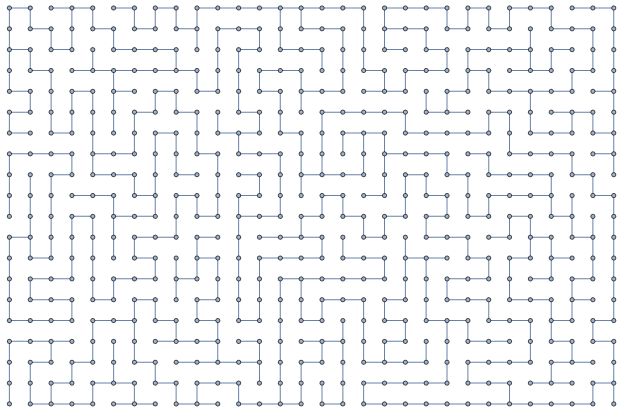前言
有一天,我在探索Mathematica的帮助文档时,发现了这么一个东西:

哪个男生不想拥有一个迷宫生成器呢?
短短十几行代码就搞定了这个问题,MMA太强了吧,在这么想的同时,才发现远远看上去阳间的代码,仔细一看,不能再阴间了。
瞧瞧这Module, AnnotationValue, Sow-Reap对, 还有Do, While, With循环, 最可怕的还是/. /; /[Not]这些符号,代码短了,可代码可读性也太低了吧(那是你看不懂而已
所以必须要好好分析一下这段阴阳两隔的代码(后经证实,非常阳间且人性化
FindShortestPath——求指定顶点间的最短路径
FindShortestPath[g,s,t]
求图 g 中从源顶点 s 到目标顶点 t 的最短路径.
FindShortestPath[{v->w,...},...]
使用规则 v->w 指定图 g.
FindShortestPath 可用于无向图、有向图、加权图、多重图和混合图.
示例程序——通过对网格图的随机深度优先搜索创建一个迷宫
g = GridGraph[{20, 30}]
m = Graph[VertexList[g],
Module[{stack = {RandomChoice[VertexList[g]]}},
Do[
AnnotationValue[{g, v}, "Visited"] = False, {v,
VertexList[g]}];
AnnotationValue[{g, First@stack}, "Visited"] = True;
While[Not[stack == {}],
With[{v = First@stack},
With[{adj =
Cases[EdgeList[g,
v - _] /. {v - u_ :> u,
u_ \[UndirectedEdge] v :> u},
x_ /; \[Not] AnnotationValue[{g, x}, "Visited"]]},
If[adj == {},
stack = Rest@stack,
With[{w = RandomChoice[adj]},
PrependTo[stack, w];
AnnotationValue[{g, w}, "Visited"] = True;
Sow[v - w]]]]]]] // Reap // Last //
First, VertexCoordinates -> GraphEmbedding[g]];
HighlightGraph[m,
PathGraph@
FindShortestPath[m, First@VertexList[m], Last@VertexList[m]]]RandomChoice[VertexList[g]]out: 591 得到图g的顶点{1,2,…,599,600}中的任意一个数
AnnotationValue[{obj,itemspec},key] gives the annotation value associated with key for items specified by itemspec in obj.
Do[AnnotationValue[{g, v}, "Visited"] = False, {v, VertexList[g]}];out: 将图g中的v(VertexList[g]={1,···,600})个顶点的Visited标记设为False;
AnnotationValue[{g, First@stack}, "Visited"] = True;而栈顶的Visited标记设为True;
While[Not[stack == {}],
With[{v = First@stack},
With[{adj =
Cases[EdgeList[g,
v \[UndirectedEdge] _] /. {v \[UndirectedEdge] u_ :> u,
u_ \[UndirectedEdge] v :> u},
x_ /; \[Not] AnnotationValue[{g, x}, "Visited"]]},
If[adj == {},
stack = Rest@stack,
With[{w = RandomChoice[adj]},
PrependTo[stack, w];
AnnotationValue[{g, w}, "Visited"] = True;
Sow[v \[UndirectedEdge] w]]]]]]第一层——While循环
While[test,body] 重复计算 test,然后是 body,直到 test 第一次不能给出 True.
当栈非空时进行循环
第二层——With循环
With[{x=x0,y=y0,...},expr]
指定在 expr 中出现的符号 x、y、...应当由x0、y0、... 替换.
说人话就是将expr中的符号替换
With[{v = First@stack},...]将v设置为栈顶元素并交给后面的表达式
EdgeList[g, v-_ ] /. {v-u :> u,u_ [- v :> u}
第三层——With循环
With[{adj = Cases[EdgeList[g,v-_]/.{v-u_:>u,u_-v:>u},x_/;!AnnotationValue[{g,x},"Visited"]]},
...]EdgeList[g, v - _] 为图g中节点v与任意连接节点的集合
例: EdgeList[g, 55 - _] %_ for blank
out: {35 - 55, 54 - 55, 55 - 56, 55 - 75}ReplaceAll (/.) 全部替换 expr/.rules 应用一个规则或规则列表尽可能转换一个表达式 expr 的每个子部分. 例: 用模式把变量和匹配的部分结合在一起: 1 + x^2 + x^4 /. x^p_ :> f[p] out:1 + f[2] + f[4]
EdgeList[g,v-_]/.{v-u_:>u,u_-v:>u}Condition (/;) 条件
patt/;test
是一个模式,仅当 test 为 True 时才匹配.
lhs:>rhs/;test
表示一个规则,仅当 test 为 True 时才应用.
lhs:=rhs/;test
是一个仅当 test 为 True 时使用的定义.
例:
对符合负值条件的所有元素进行替换:
{6, -7, 3, 2, -1, -2} /. x_ /; x < 0 -> w
out: {6, w, 3, 2, w, w}
x_ /; \[Not] AnnotationValue[{g, x}, "Visited"]作为Cases的条件,含义是图g中节点x的标记为假
Cases 模式匹配
Cases[{e1,e2,...},pattern(->rhs)]
给出了匹配模式pattern的 e1 (的 rhs 值)的列表.
例:
从每一个匹配的 f[x_] 内部返回 x :
Cases[{1, 1, f[a], 2, 3, y, f[8], 9, f[10]}, f[x_] -> x]
out: {a, 8, 10}
{adj = Cases[EdgeList[g,v-_]/.{v-u_:>u,u_-v:>u},x_/;!AnnotationValue[{g,x},"Visited"]]}adj为Cases返回的, 在图g中节点v(栈顶)的邻接节点中未被访问(Visited == False)的节点列表.
不妨称adj为未访问过的邻接表a.
第五层——if条件
If[adj == {},
stack = Rest@stack,
With[{w = RandomChoice[adj]},
PrependTo[stack, w];
AnnotationValue[{g, w}, "Visited"] = True;
Sow[v - w]]]如果表a为空, 则说明该节点已经无路可走, 则从栈顶移去
stack等于去掉首位的stack
第六层——With循环
With[{w = RandomChoice[adj]},
PrependTo[stack, w];
AnnotationValue[{g, w}, "Visited"] = True;
Sow[v - w]]在表a中随机选择一个节点w放置到栈顶并将w的Visit标记设为True.
Sow 散布
Sow[e]
指定 e 可以从最近的封闭的 Reap 中提取.
Sow[e,{tag}]
指定 e 可以从最近的封闭的 Reap 中提取,其中它的模式匹配 {tag}.
Reap 收获
Reap[expr]
给出表达式 expr 的值,以及在计算中已经应用 Sow 的所有表达式. 使用 Sow[e] 或具有不同标记的 Sow[e,Subscript[tag, i]] "散布"的表达式在不同列表中给出.
在广义循环中, 使用Sow记录每一步e的值, 再由Reap收获
Sow[v - w]散布了原栈顶结点与新栈顶节点(原栈顶节点的邻接节点)的无向图
跳离循环
收获之后, 很显然第一个元素是null {null,{..}}, 所以要选择Last{{…}}, 再选择第一个{…}, 将g的绘图坐标转交给m.
结果

HighlightGraph[m,
PathGraph@
FindShortestPath[m, First@VertexList[m], Last@VertexList[m]]]
阳间
如果作为程序编写者而言,这样的代码是非常符合思考逻辑的,可以无缝的将思路转换为代码,可谓极致阳间了。
对于阅读者而言,只要了解了语法,怎么会看不懂呢?(XD


tql, 张大佬
_(:з)∠)_